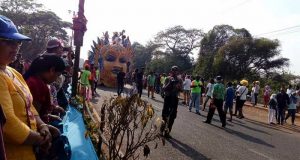Ajanta Caves: A Mystical Tourist Destination in Maharashtra
The breathtaking and jaw dropping historical places of India feature a very famous group of caves called the Ajanta Caves. These caves have been in existence for a very long period now and from the time these were discovered, they have been appealing tourists from near and far-off places in a bid to explore the external and inner beauty and the mystic realistic experience one goes through while roaming around the caves.

Location
The Ajanta Caves are located in the outskirts of Ajintha, a village that falls in the district of Aurangabad in Maharashtra.
History
Ajanta caves are a group of thirty Buddhist monuments that can be traced back to the second century. The caves were a Buddhist monastery, where a large number of educational institutes were operational. A renowned Buddhist philosopher by the name Dinnaga is believed to have spent considerable amount of time at the caves.
The construction of the caves took place in different phases. The first phase of construction was carried out under the reign of Satavahana Dynasty, during which five caves were built.
The first phase was completed in between the 2nd and 3rd century, while the second phase was initiated during the 5th century. During this period, depicting Buddha through sculptures and paintings was the norm.
A research led by Walter M. Spink, an expert in archaeology, stated that majority of the work was carried out within a period of twenty years during the 4th century. Several caves were carved out simultaneously at this time. Soon after the completion of around twenty caves, the site was abandoned for reasons unknown, following which the caves got surrounded by dense forests with no visibility.
Several centuries later, the caves came into notice of a British officer who was busy hunting in the forests. He inscribed his name and the date of his visit, April 28 1819, on one of the cave walls. The information regarding the existence of the caves reached the Bombay Literary Society and in the following years, the caves became a favourite spot among the visitors who appreciated the location, structure, and the beauty of these caves.
Royal Asiatic Society set up a commission in 1848 as a measure to clean and preserve such sites in the whole Bombay Presidency. Bombay Cave Temple Commission, as it was named, carved the path for the formation of the Archaeological Survey of India.
The caves are famous for the mural paintings which still exist and charm the onlookers, apart from being an inspiration for the modern day artists. These paintings were replicated and were put in two museums in London, but they met with an ill fate and were destroyed in a fire. Following the two incidents of fire at two different locations, the authorities decided to store the rest of the replicas rather than putting them on show again.
The paintings depict the mastery of Indian painters of that era and the lifestyle of the rich and affluent people.
This historical site was designated as a UNESCO World Heritage Site in 1983.
Structure
The structure of the caves represents the viharas built as a part of the monastery. The shrine consists of a large statue of Lord Buddha. There are several halls built in a slightly different manner from the dormitories of the monastery, with a higher ceiling and considerably large in length. The difference in the structure of the viharas and the halls is due to the latter being constructed in a later period.
The first and the second caves that the tourists come across are located adjacent to each other though the structure of both the caves is very different from each other. The fourth cave of the group is stated to be the largest, yet incomplete cave amongst all.
Eat, Drink, Collect
Though there is not much to eat around the caves, you can get your share of meals and drinks at one of the various restaurants in Jalgaon or Aurangabad.
Best Time to Visit
The caves remain open from 09:00 am to 05:00 pm. They remain closed on Mondays. Though the caves are open all year long, the tourists should avoid visiting it during the summer and monsoon, as it become a daunting task to explore the beauty of this vast expanse in the heat or rains.
It is advised that you spare at least six to eight hours if you want to explore all the caves.
Indian citizens and citizens from SAARC countries are required to pay an entrance fee of Rs. 10/- per head. Visitors from other countries are required to pay Rs. 250/- towards admission. An additional Rs. 5/- is charged for using a camera. Use of flash is prohibited inside the caves.
How to Reach
Aurangabad airport is the closest airport to Ajanta Caves. It provides connectivity with metro cities such as Delhi and Mumbai and other centres of India. The authorities are also planning to establish an airport at Jalgaon, which will further reduce time taken to reach the caves.
The closest railway station from the caves is at Jalgaon, at a distance of around 59 kilometres. The railway station provides connectivity with major states of India, which may or may not be connected through air transport.
From Aurangabad and Jalgaon, the tourists can hire a private taxi or board a bus for the Ajintha village.
Ajanta caves provide a deep insight not just into the mystic carving process of that era, but also the education system adopted by the Buddhist groups. It is a perfect place where you will be able to rediscover history and recognize the importance of ancient art, culture, traditions, and all other factors that have somehow contributed in creating the present society we live in.


